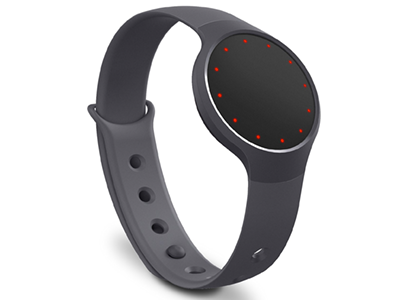Tom's Guide Verdict
The $50 Misfit Flash is a discreet, comfortable activity tracker that will let you dip your toe into fitness without requiring you to spend big bucks.
Pros
- +
Inexpensive
- +
Waterproof and supports swimming
- +
Can be worn in a wristband or clip
- +
Basic, but accurate, sleep tracking
Cons
- -
Sensor can slip out of wristband
- -
Wristband feels cheap
Why you can trust Tom's Guide
Getting fit in 2014 can be expensive. Maybe you don't have $200 to spend on an elite fitness tracker — or maybe you just don't want to — but you still want to get in shape on your own terms. Fitness-tracking technology is getting more accessible by the day, and the $50 Misfit Flash is proof of that. This inexpensive wearable tracks all the basic fitness metrics you'd expect from a fitness tracker in a friendly, unobtrusive design that's also swimmer-friendly. But how much function do you really get for the price?
Design
The Misfit Flash is a small sensor, a little larger than a quarter, made of smooth, matte plastic. It has a nearly invisible LED display, which really only shines small dots around the edges to show progress and time when you press the middle of the sensor.
The Flash's small size makes it a versatile little companion. You can wear it in the included wristband or clip, so there's no excuse not to wear it all the time. I love that the Flash is a set-and-forget type of tracker. I eventually forgot it was even on me.
The Flash is also waterproof, so I didn't have to worry when I showered with it. You can swim with it too, and it can track your underwater activity.

To top it off, the Flash sensor comes in fun colors like fuchsia, zest (a bright yellowish-green color), wave (a vibrant blue) and "Coca-Cola red." My review unit came in the sleek and subtle Onyx color, with a matte black sensor and a dark-gray clip and wristband.
MORE: Best Fitness Trackers
While it's more flexible than the Fitbug Orb, which you can only wear as a clip-on for your clothing, the Flash has a few design drawbacks. The wristband is made of a hard plastic that makes it hard to clasp and feels a little cheap. I also found the sensor popped out of the wristband occasionally when I pushed down on it to view my progress or the time. However, tightening the wristband around my arm so it was snug prevented the sensor from falling out.

The sensor stays in the clip much better, but it was also harder to insert because it's a tighter fit. At least once you get the sensor into the clip, you won't have to worry about losing it.
The Flash lacks a vibration alert system, but I didn't really miss it.
Display
The Flash's display takes a bit of decoding and understanding to master. Pressing down on the top of the sensor first reveals your daily goal progress as glowing dots of light in a circle around the edge of the sensor. The more the circle lights up, the farther you are toward reaching your activity goal for the day.
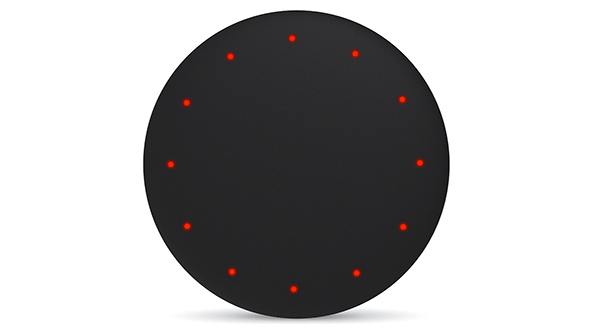
After that, the dots of light show the time; the hour dot glows with a steady light, and the minute dot flashes. Dots standing for 3, 6, 9 and 12 are half-dimmed, acting as guides for you. It takes some time to get used to, and some orientation. I had to press the sensor a few times to get the correct time in my head, and then turn the sensor so that the 12th hour was at the top.
Setup
It doesn't take much to set up the Misfit Flash. All you have to do is download the Misfit app for either iOS or Android. Once you've downloaded the app and make a Misfit account, the sensor will pair with the app using Bluetooth 4.0.

Performance
The Misfit Flash tracked my steps, calories and distances accurately, giving me a bird's-eye view of my daily activity in the companion app. Even when I forgot to sync the Flash to the app one day, all of my information was stored and flooded the app when I finally did sync it. Similarly to the Fitbug Orb, the Flash focuses on steps, calories and distance; it doesn't track steps climbed or heart rate.
App
The Misfit Flash's companion app for iOS and Android collects all the information from your sensor and presents it to you in a plain and simple design. The home screen shows a circle that tracks your progress, and in the middle of the circle are your current activity points and the number of minutes of activity you need to complete to meet your daily goal. Tap the middle of the circle to reveal your points broken down into steps, calories and distance.
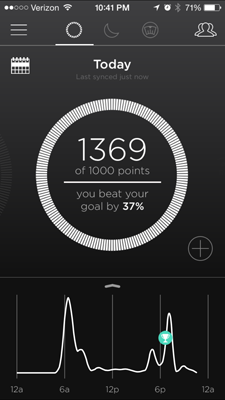
At the bottom of the home screen is a timeline of your activity, showing you the time of day when you were moving the most. Pulling up the timeline reveals the app's intelligent breakdown of your activity; it tries to guess how intense your activity was at a certain time. For example, when I was heading to the gym before work one morning, a square icon appeared with a running man inside of it. Tapping that icon showed me the time period in which Flash registered that I was walking quickly down the streets of Brooklyn to get to the subway, and it gave me points for that activity, too.
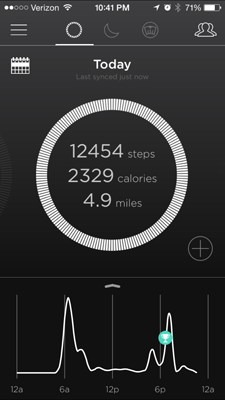
There's also an icon for you to track what you've eaten that day, but it only lets you take a photo of your food. This is similar to what you'll see on the Fitbug Orb, which doesn't have its own way of inputting your daily diet, but both devices let you easily connect to MyFitnessPal through their apps in order to track your food.
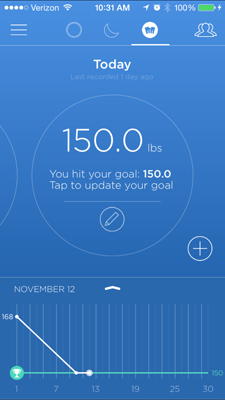
To track a specific activity, tap the small "+" right above the graph, press Track Now and pick the activity you're doing: basketball, cycling, dancing, running, swimming, soccer, tennis or yoga. You can go about using your smartphone to do things like listen to music while you're exercising, and the app tracks your workout time in the background. Go back into the app and press Done to end your session, and you can choose to sync the Flash's data immediately or later.
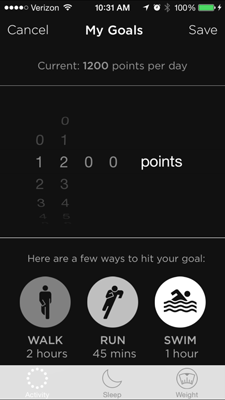
I found that the Flash and the app tracked my running accurately. They recognized when I was just lightly jogging or running faster, and gave me more or fewer points depending on my intensity. However, it would be easier if Flash just knew what activity I was doing, because I often forgot to go in and begin tracking my workouts.
MORE: 15 Great Fitness Apps
You can tap the top of the app to reveal screens for your sleep, weight and friends. The sleep page tells you how long you slept, how long you were in restful sleep and if you reached your goal. On the weight page, you have to manually enter your weight every time you want it to update, since Flash obviously doesn't act as a scale. After a few weigh-ins, you'll be able to view your progress on a timeline graph. You can also connect your Misfit account to Facebook, to sync up with friends who might also be using the tracker, and compete with them for the top spot on your fitness leaderboard.
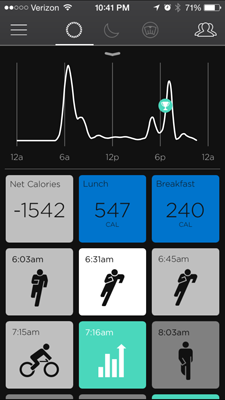
In addition, you can sync third-party apps like Lose It!, RunKeeper, Walgreens, IFTTT, MapMyFitness and MyFitnessPal to your Misfit app, to make it a little easier to track things like diet and weight. I connected MyFitnessPal to the app, and all my calories for breakfast, lunch and dinner showed up under my timeline, as well as my last login weight that MyFitnessPal had recorded.
Sleep Mode
Unlike many other trackers, including the Fitbug Orb, you don't have to put the Misfit Flash into sleep mode. It's intelligent enough to know when you're not moving and likely to be going to sleep, and I found it was pretty accurate. I typically "go to sleep" — or get in bed and try to fall asleep — at around 10:45 p.m. or 11 p.m., and my alarm is set for 6 a.m. The Flash consistently recorded me falling asleep sometime between 10:30 p.m. and 11 p.m., and I always woke up a few minutes before my alarm went off.
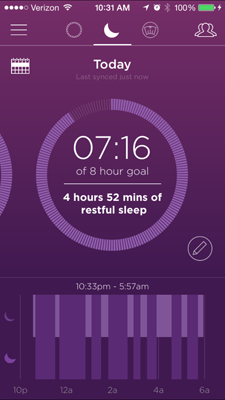
You can also set a sleep alarm through the Flash's app by swiping right on the sleep home screen. Choose the time the alarm should go off and the sound from eight nature tracks, including Campfire, Rain and Waterfall. Unfortunately, the Flash sensor itself can't wake you up.
Battery Life
Misfit claims that the Flash's coin cell battery can last up to six months. The same coin cell battery powers the Fitbug Orb, and it costs only about $1.50 to replace the battery once it dies.
Misfit Flash vs. the Competition
The Misfit Flash must battle against the Fitbug Orb and the new Jawbone Up Move for your $50, and it certainly stands up well against them. Its design is the least flashy out of the group. But it's also versatile, as it can be worn on a wristband or a clip. All three devices operate on a coin cell battery that can last up to six months.
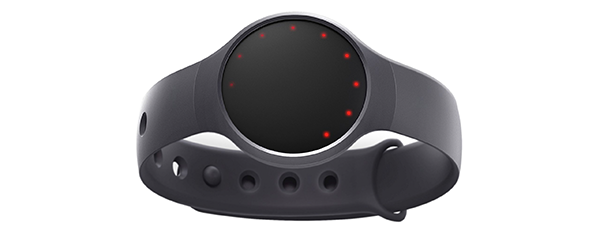
All three also track the basics: steps, calories, distance and sleep. But the Flash is the only one you don't need to manually put into sleep mode — a convenient perk and an incentive to wear it all day long. The Flash is also water-resistant up to 30 meters (about 100 feet). Neither the Up Move nor the Orb can withstand that much water.
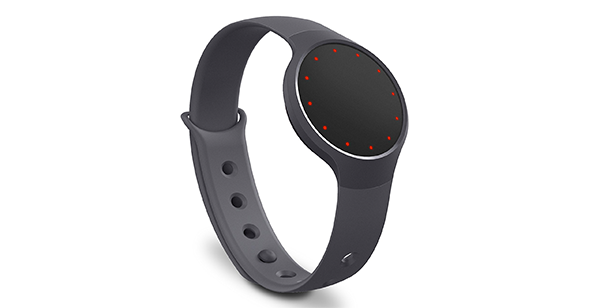
The Flash's companion app is more engaging than the Fitbug Orb's, but Jawbone still has one of the best companion apps of any fitness tracker. Also, the Up Move's app has Smart Coach, a new feature that helps you understand your habits and suggests ways for you to get healthier. The Flash just sticks to collecting and presenting your data in a lovely way.
Bottom Line
Small, discreet and functional, the Misfit Flash is a great choice for those who want to be more active but don't want to spend a lot. It's easier to wear than the Fitbug Orb, and you don't have to worry about turning on sleep mode before you go to bed, as you do with the Orb. However, if you want to have more guidance and advice, you might want to hold out for the Jawbone Up Move.
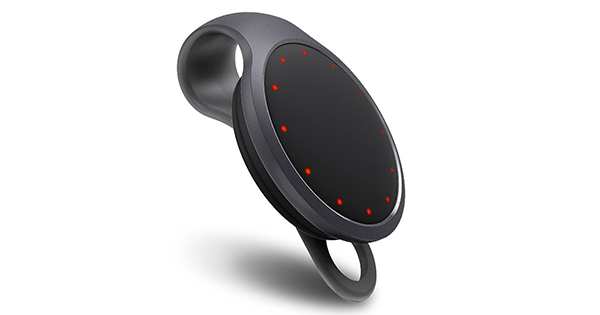
Overall, the Misfit Flash is comfortable to wear — so much so that you might forget you have it on — and its app beautifully displays your fitness data in a clear way so you can understand it.
Follow Valentina Palladino at@valentinalucia. Follow Tom's Guide at @tomsguide and on Facebook.
Valentina is Commerce Editor at Engadget and has covered consumer electronics for a number of publications including Tom's Guide, Wired, Laptop Mag and Ars Technica, with a particular focus on wearables, PCs and other mobile tech.
